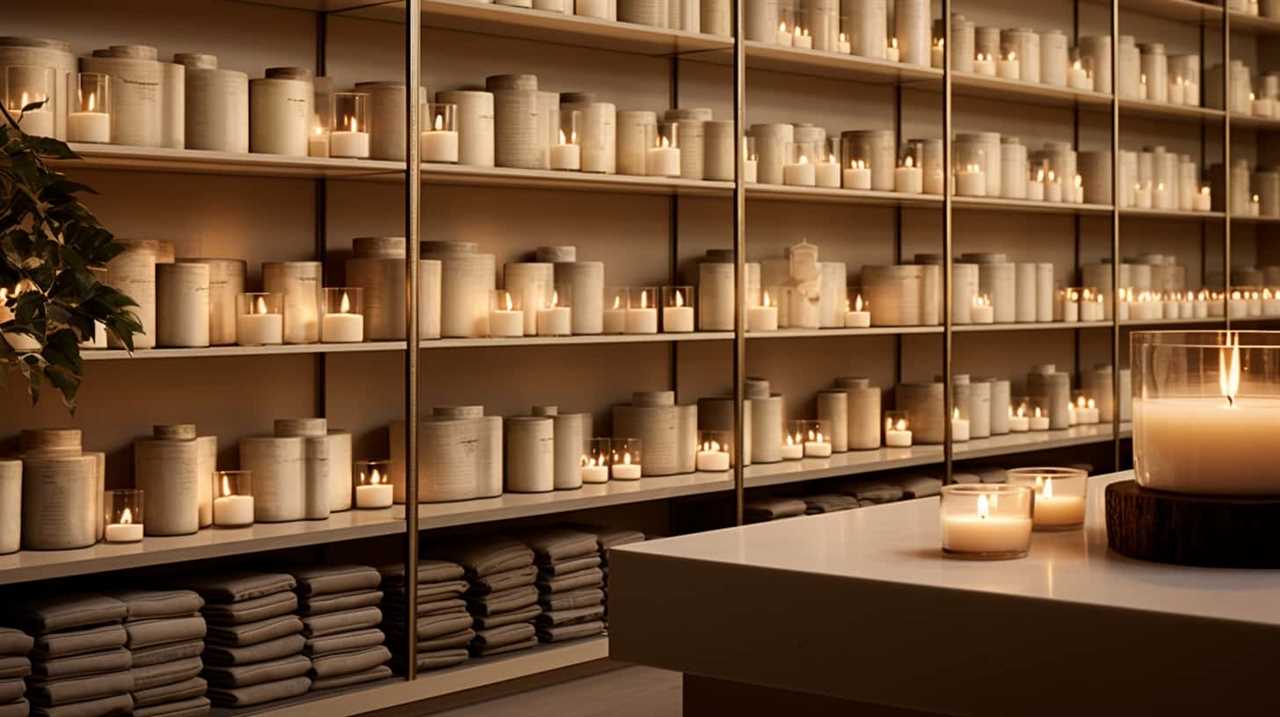When a loved one dies, we often seek solace in rituals and customs. One popular custom is lighting a candle in memory of the departed. But which color candle should we choose?
In this guide, we will explore the significance of different colored candles and their connection to mourning and remembrance. By understanding the symbolism behind each color, we can find a candle that resonates with our emotions and honors the memory of the departed.
From white candles symbolizing purity and spiritual connection, to black candles traditionally used to signify mourning, we will delve into the rich tapestry of colors that can help us navigate the grieving process with grace and reverence.
Key Takeaways
- White candles symbolize purity, cleanliness, and the soul’s journey towards enlightenment.
- Red candles represent love, strength, and courage, invoking the qualities of the departed loved one.
- Blue candles promote calmness, peace, and emotional healing during the grieving process.
- Purple candles signify spiritual growth, transformation, and a deeper connection with the divine.
White Candles: Symbol of Purity and Spiritual Connection
When someone dies, we honor their memory and spiritual connection by burning white candles. White candles hold a deep symbolism of purity and spiritual significance. The color white represents purity and cleanliness, symbolizing the soul’s journey towards enlightenment and transcendence.

Lighting white candles during times of grief and remembrance helps create a sacred space for reflection, healing, and connecting with the departed loved one’s spirit. The soft glow of the white flame brings a sense of peace and tranquility to the environment, allowing us to tap into our spiritual selves and find solace amidst the pain.
White candles also serve as a reminder of the eternal light that exists beyond the physical realm, offering hope and comfort in times of mourning. Their presence encourages us to embrace both the physical and spiritual aspects of our existence, fostering a deeper understanding of life’s mysteries.
Red Candles: Represents Love, Strength, and Courage
To further explore the symbolism of candles when someone dies, let’s delve into the significance of red candles, which represent love, strength, and courage. Red is a powerful color that holds deep symbolic meanings in various cultures and traditions. When we light a red candle to honor a loved one who has passed away, we are invoking the qualities of love, strength, and courage that they embodied in their life. The vibrant red flame reminds us of the passion and intensity of their love, the resilience and fortitude they displayed in times of adversity, and the bravery they demonstrated in facing life’s challenges. Just as white candles represent purity and spiritual connection, red candles serve as a beacon of love, strength, and courage, guiding us through the grieving process and reminding us of the indomitable spirit of our loved ones.
| Symbolic Meanings of Red | Significance of White Candles |
|---|---|
| Love | Purity |
| Strength | Spiritual Connection |
| Courage |
Blue Candles: Promotes Calmness and Peace During Grieving
Blue candles offer a sense of calmness and peace during the grieving process. The symbolic significance of blue is often associated with tranquility and serenity, making it a perfect choice for those seeking solace in their time of loss. Here are three ways in which blue candles can help in finding peace during the grieving process:
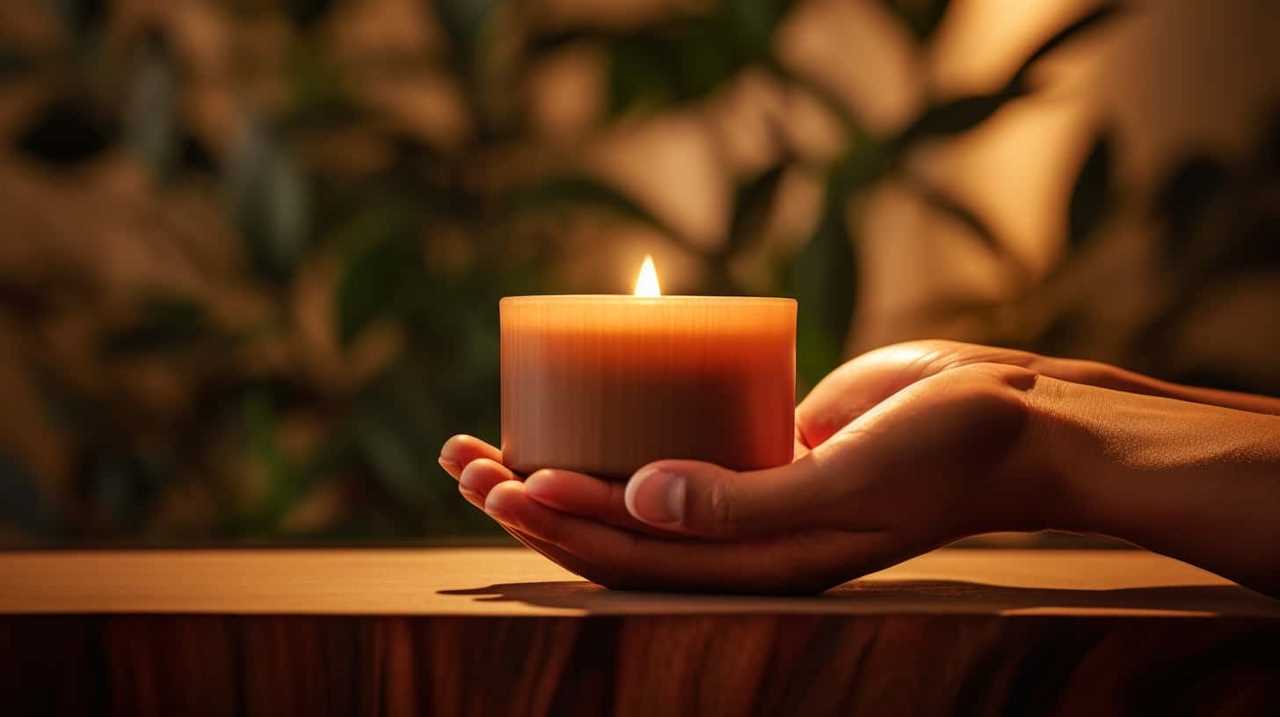
- Creating a soothing atmosphere: Lighting a blue candle can create a peaceful ambiance, providing a gentle and comforting presence in the room. The soft glow can help to calm the mind and promote a sense of tranquility.
- Encouraging emotional healing: Blue is known to be a color that brings about emotional healing. Burning a blue candle can help to release pent-up emotions, allowing for a cathartic experience and aiding in the process of grief.
- Symbolizing hope and faith: Blue candles can serve as a reminder of hope and faith during difficult times. The color blue is often associated with trust, stability, and faith, providing a sense of reassurance and strength in the midst of grief.
Finding peace through blue candles is a personal journey, and each individual may experience its effects differently. However, the calming presence of a blue candle can offer solace and comfort during the grieving process.
Purple Candles: Signifies Spiritual Growth and Connection With the Divine
Our connection with the divine is deepened through the spiritual growth symbolized by purple candles. The symbolic significance of purple in spirituality is profound, representing transformation, enlightenment, and connection with higher realms. When we light a purple candle, we invite spiritual growth and seek to strengthen our bond with the divine.
The color purple has long been associated with mysticism and the expansion of consciousness. By incorporating purple candles into our rituals and meditation practices, we open ourselves up to receiving divine wisdom and guidance. The calming and soothing energy emitted by these candles helps us to connect with our inner selves and tap into our spiritual potential.
As we embrace the spiritual growth facilitated by purple candles, we embark on a journey of self-discovery and a deeper connection with the divine.
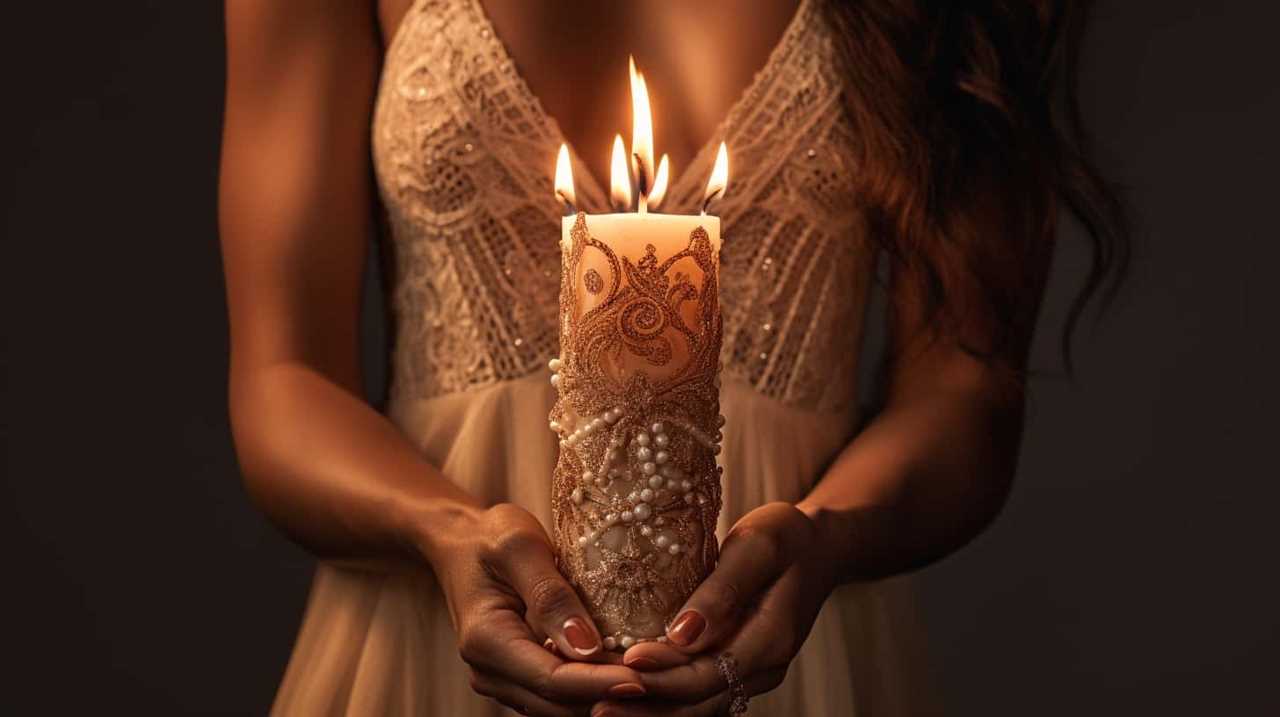
Transitioning into the subsequent section about ‘green candles: symbolizes renewal, hope, and healing’, we find solace in the vibrant energy of green candles.
Green Candles: Symbolizes Renewal, Hope, and Healing
As we continue our exploration of the symbolism behind different colored candles to burn when someone dies, let’s now shift our focus to green candles.
Green, a color often associated with renewal, hope, and healing, holds deep meaning in the grieving process. It represents the opportunity for growth and rejuvenation, reminding us that even in times of loss, there’s the possibility for healing and moving forward.
Symbolic Meaning of Green
When someone passes away, we can find solace and comfort in the symbolic meaning of green candles, which represent renewal, hope, and healing.
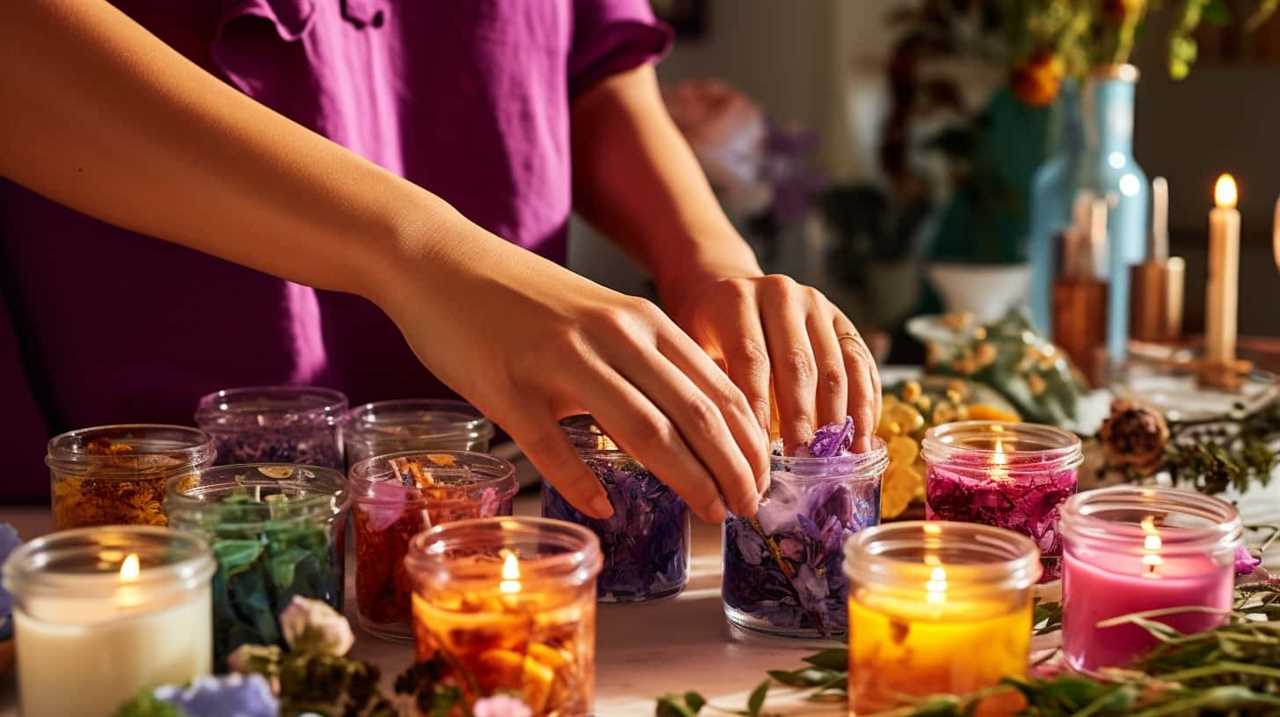
Green is often associated with nature and growth, reminding us of the cycle of life and the potential for new beginnings. Burning a green candle can have healing benefits for those experiencing grief, as it symbolizes the process of healing and moving forward.
The spiritual symbolism of green is also significant, as it represents balance and harmony. Lighting a green candle can help create a calming and peaceful atmosphere, providing a sense of renewal and hope during difficult times.
Whether used in meditation, prayer, or simply as a visual reminder, green candles can serve as a powerful symbol of healing and resilience.
Healing Properties of Green
Green candles have healing properties that symbolize renewal, hope, and healing, making them a powerful tool for finding solace and comfort when someone passes away. The symbolic representation of green as a color of renewal and growth can provide a sense of hope and rejuvenation during difficult times. Green candles have been used for centuries in various spiritual practices and rituals to promote healing and balance. The benefits of healing with green candles include the ability to release negative energy, promote emotional and physical well-being, and restore a sense of harmony and peace. The table below highlights some of the specific benefits that green candles can offer in the healing process:
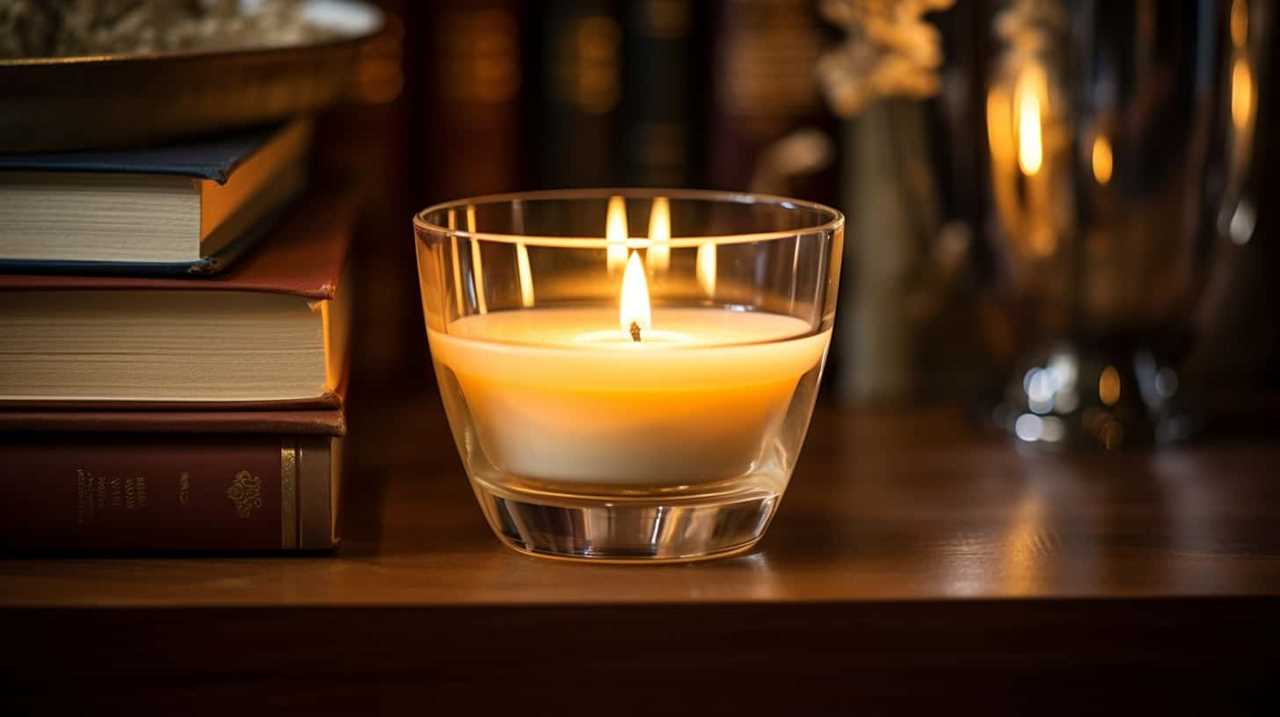
| Benefits of Healing with Green Candles |
|---|
| Promotes overall healing and restoration |
| Aids in emotional healing and releasing grief |
| Encourages renewal and growth |
| Helps to restore balance and harmony |
| Brings a sense of hope and optimism |
Using Green for Renewal
Continuing with our exploration of the healing properties of green candles, we can harness their power for renewal, hope, and healing. Green candles hold a symbolic significance when it comes to emotional well-being, making them a perfect choice during times of loss and mourning.
Here are three ways in which green candles can help in our journey of renewal and healing:
- Renewal: Lighting a green candle can serve as a reminder of the cyclical nature of life, bringing a sense of renewal and growth amidst grief.
- Hope: The vibrant green color of the candle represents hope, reminding us that even in the darkest of times, there’s always a glimmer of light and possibility.
- Healing: Green candles have a calming effect on our emotions, promoting healing and helping us find solace during times of sorrow.
As we reflect on the power of green candles for renewal, hope, and healing, let’s now move on to explore the significance of yellow candles in representing optimism and positivity during the mourning process.
Yellow Candles: Represents Optimism and Positivity During the Mourning Process
We choose to burn yellow candles during the mourning process as they symbolize optimism and positivity. The symbolism of yellow represents hope, joy, and happiness, which are essential during the grieving period. Yellow candles help create an atmosphere of warmth and light, reminding us that life continues and there’s still beauty to be found even in the midst of sorrow.
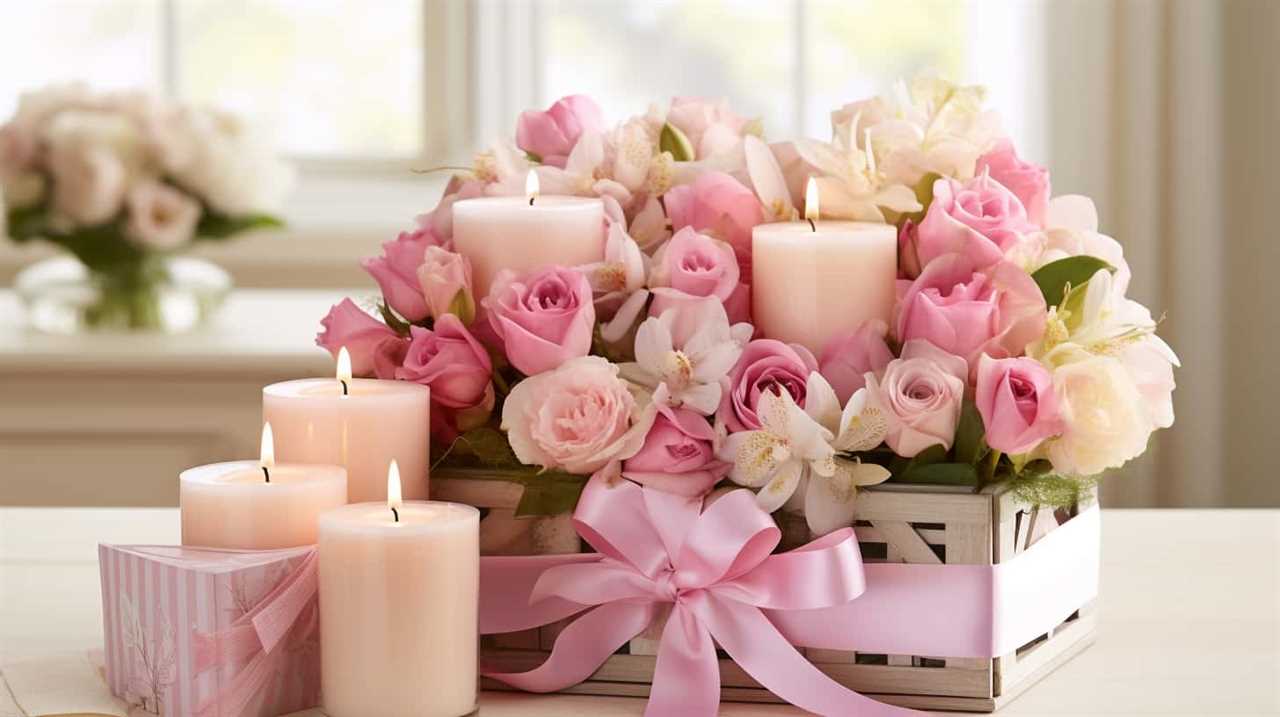
The vibrant energy of yellow can uplift our spirits and bring a sense of comfort and solace. Combining yellow candles with pink ones can enhance emotional healing. Pink is associated with love, compassion, and nurturing, providing a gentle and soothing energy.
Together, yellow and pink candles create a space that encourages optimism, positivity, and the belief that brighter days lie ahead.
Orange Candles: Encourages Enthusiasm and Energy to Remember the Deceased
During the mourning process, we can use orange candles to evoke enthusiasm and energy in remembering the deceased. The symbolic significance of orange lies in its association with creativity, joy, and warmth. Burning orange candles can help us tap into these qualities and channel them towards honoring our loved ones who’ve passed away.
Here are three ways in which orange candles can contribute to emotional healing and remembrance:

- Igniting Inspiration: The vibrant orange flame can serve as a visual reminder to celebrate the life of the departed and find inspiration in their legacy. It encourages us to remember the happy moments shared and the impact they’d on our lives.
- Invigorating Energy: The warm glow of an orange candle can infuse the mourning space with renewed energy and vitality. It can help combat feelings of sadness and provide a sense of comfort and strength during the grieving process.
- Fostering Connection: Lighting orange candles can create a warm and inviting atmosphere where family and friends can come together to share stories, memories, and anecdotes about the deceased. This shared experience promotes a sense of unity and support, allowing us to connect and heal together.
Pink Candles: Symbol of Love, Compassion, and Emotional Healing
When someone passes away, we often find solace in the healing power of pink candles. These candles serve as a symbolic representation of love, compassion, and emotional healing.
Lighting a pink candle can create a gentle and comforting atmosphere that allows us to process our emotions and find comfort in the midst of grief.
Healing Power of Pink
Pink candles represent love, compassion, and emotional healing, making them a powerful symbol in the process of healing after the loss of a loved one. The healing properties of pink can provide solace and comfort during times of grief, offering a gentle embrace for our wounded hearts.
Here are three ways pink candles can aid in emotional healing:

- Promoting love: Pink candles radiate a soft and nurturing energy that helps us reconnect with the love we shared with the departed. Lighting a pink candle can create a loving atmosphere, reminding us of the deep bond we had and allowing us to honor and cherish their memory.
- Fostering compassion: Pink candles inspire feelings of compassion and understanding. They encourage us to be gentle with ourselves and others as we navigate the complex emotions that arise after a loss. By embracing compassion, we can find solace and support in our healing journey.
- Facilitating emotional healing: Pink candles have a soothing effect on our emotions, creating a safe space for us to process our grief. They provide a gentle reminder that healing is a gradual process, and it’s okay to take the time we need to heal emotionally. By using pink candles, we can embrace our emotions and begin to find peace and healing amidst the pain.
Incorporating pink candles into our healing rituals can bring a sense of comfort and aid in the emotional healing process. Their loving and compassionate energy can help us navigate the difficult journey of healing after losing a loved one.
Symbolic Representation of Love
As we light pink candles in remembrance, we symbolize the profound love, compassion, and emotional healing that they represent.
Pink candles hold a symbolic representation of grief, offering solace and comfort to those who are grieving the loss of a loved one.
The soft, gentle hue of pink evokes a sense of tenderness and warmth, reminding us of the love that we shared with the departed.
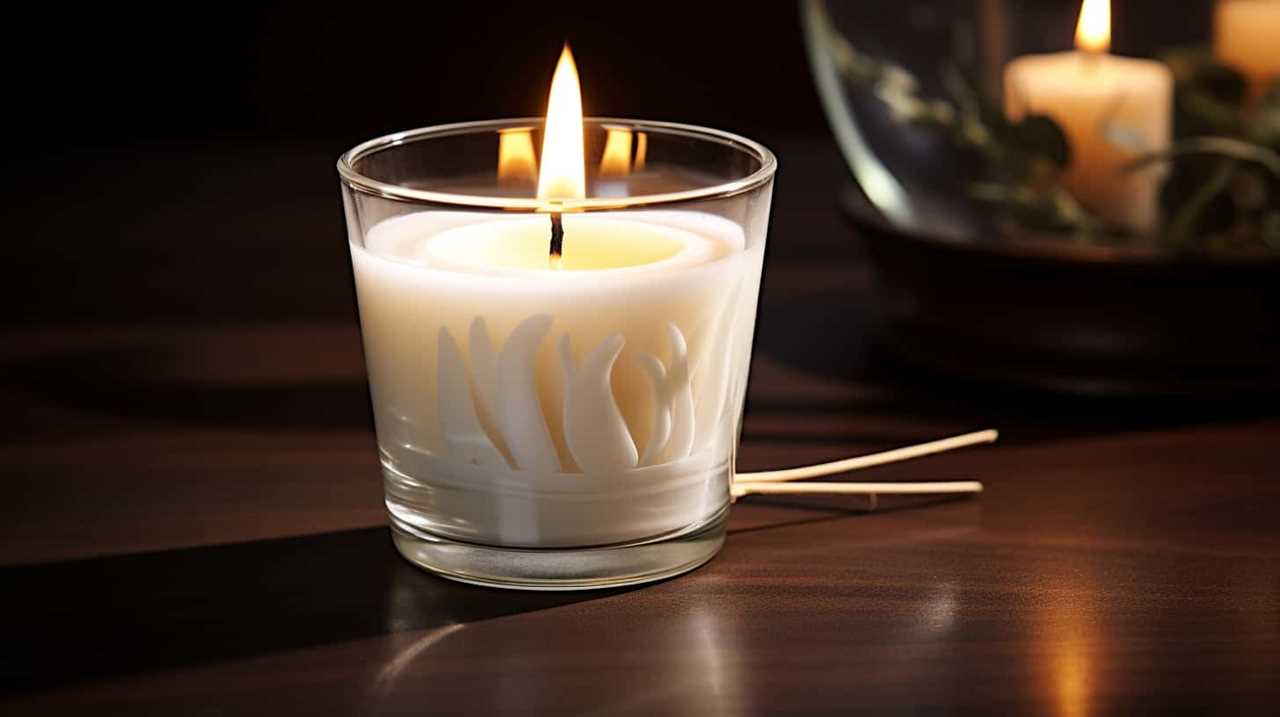
Lighting a pink candle during times of sorrow can help us find solace in symbolism, as it serves as a visual reminder of the love and compassion that continue to surround us, even in the absence of our loved one.
The flickering flame offers a sense of emotional healing, a gentle reminder that love transcends physical boundaries, and that our connection to the departed is everlasting.
Black Candles: Traditionally Used to Honor the Deceased and Signify Mourning
We typically use black candles to honor the deceased and symbolize mourning. The symbolism of black candles holds great cultural significance, as it represents the solemnity and reverence we feel when someone passes away. Here are three reasons why black candles are traditionally used in times of mourning:
- Mourning and Remembrance: Lighting a black candle allows us to create a space for reflection and remembrance. It serves as a physical symbol of our grief, allowing us to honor the memory of our loved ones who’ve passed.
- Offering Support: Burning a black candle during a period of mourning can also serve as a way to show support and solidarity with those who are grieving. It lets them know that they aren’t alone in their sorrow and that we stand with them in their time of need.
- Closure and Healing: The act of lighting a black candle can provide a sense of closure and healing. It allows us to acknowledge our pain and begin the process of healing and moving forward.
As we reflect on the symbolism and cultural significance of black candles, we transition to the next topic: silver candles. These candles represent reflection and honoring the memory of the deceased.
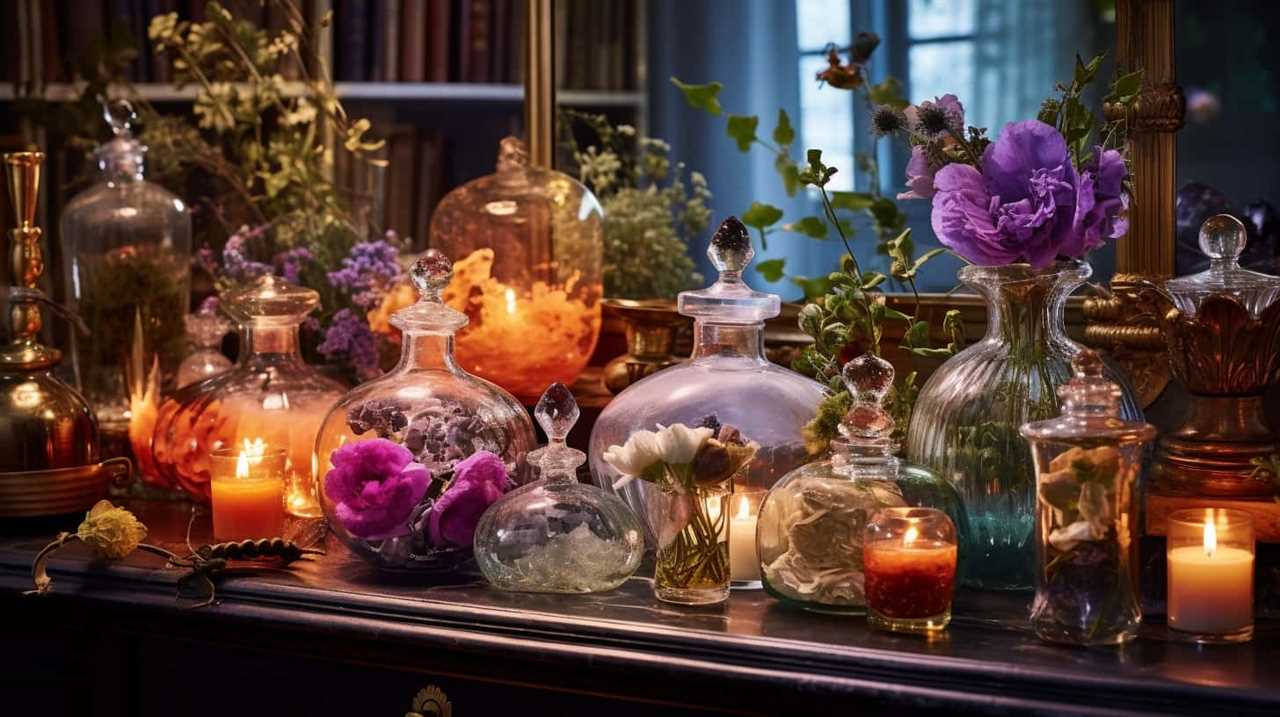
Silver Candles: Represents Reflection and Honoring the Memory of the Deceased
Silver candles hold a significant meaning as they represent reflection and the act of honoring the memory of the deceased. When we light a silver candle, we invite moments of contemplation and introspection, allowing us to reflect on the life and legacy of our loved ones.
The soft, flickering light of the silver candle creates a serene environment, encouraging us to remember the cherished moments we shared with the departed. It symbolizes the importance of taking the time to honor their memory and celebrate the impact they had on our lives.
Through the gentle glow of a silver candle, we can find solace in our memories and find comfort in the knowledge that our loved ones will always be with us in our hearts.
As we move forward, let’s now explore the symbolism of gold candles, which represent enlightenment and celebrating the life of the deceased.

Gold Candles: Symbolizes Enlightenment and Celebrating the Life of the Deceased
Gold candles symbolize the enlightenment and celebration of the life of the deceased. In times of mourning, lighting a gold candle can serve as a powerful tribute to honor the person who’s passed away. Here are three reasons why gold candles hold such symbolic significance and embody the meaning of enlightenment:
- Illuminating the path: Gold represents light and illumination, reminding us that even in the darkest times, there’s always a glimmer of hope. Burning a gold candle signifies the journey towards enlightenment and understanding, guiding us through the grieving process.
- Celebrating a life well-lived: Gold is often associated with joy and abundance. Lighting a gold candle allows us to shift our focus from mourning to celebrating the beautiful moments and accomplishments of the deceased. It symbolizes gratitude for the life they lived and the impact they made on others.
- Embracing spiritual growth: Gold is a color often associated with wisdom and spiritual growth. Burning a gold candle can serve as a reminder to reflect on the lessons learned from the life of the deceased, encouraging personal growth and transformation.
Frequently Asked Questions
Are There Any Specific Rituals or Prayers That Should Be Performed When Burning a White Candle for Someone Who Has Passed Away?
When someone passes away, burning a white candle holds significance in different religious practices. We’ve heard stories of individuals who found solace in lighting white candles during their mourning rituals, bringing comfort and peace.
Can I Combine Different Colored Candles to Represent Different Aspects of the Deceased’s Personality or Qualities?
We can combine different colored candles to symbolize different aspects of the deceased’s personality and qualities. It’s a personalized way to remember them. Each candle represents a unique trait, creating a meaningful tribute.
Is It Appropriate to Burn a Black Candle for Someone Who Was Not a Close Family Member or Friend?
It is customary to burn a black candle for someone who was not a close family member or friend. However, there are alternative candle colors that can be used when someone dies, such as white or purple.

Are There Any Cultural or Religious Traditions That Dictate Which Color Candle Should Be Used When Someone Dies?
When someone dies, cultural significance and symbolism in candle colors may dictate which color candle to burn. Different cultures and religions have their own traditions and beliefs surrounding this practice.
Can I Reuse a Candle That Has Been Burned for Someone Who Has Passed Away, or Should I Dispose of It in a Specific Way?
When someone passes away, it’s important to consider candle burning etiquette for honoring the departed. Regarding the current question, it’s generally recommended to dispose of the candle in a respectful manner rather than reusing it.
Conclusion
In conclusion, when it comes to choosing a color candle to burn when someone dies, it’s important to consider the symbolism and meaning behind each color.
While some may argue that the choice of candle color may not have a significant impact, it can provide a visual representation of our emotions and help us find solace and healing during the grieving process.
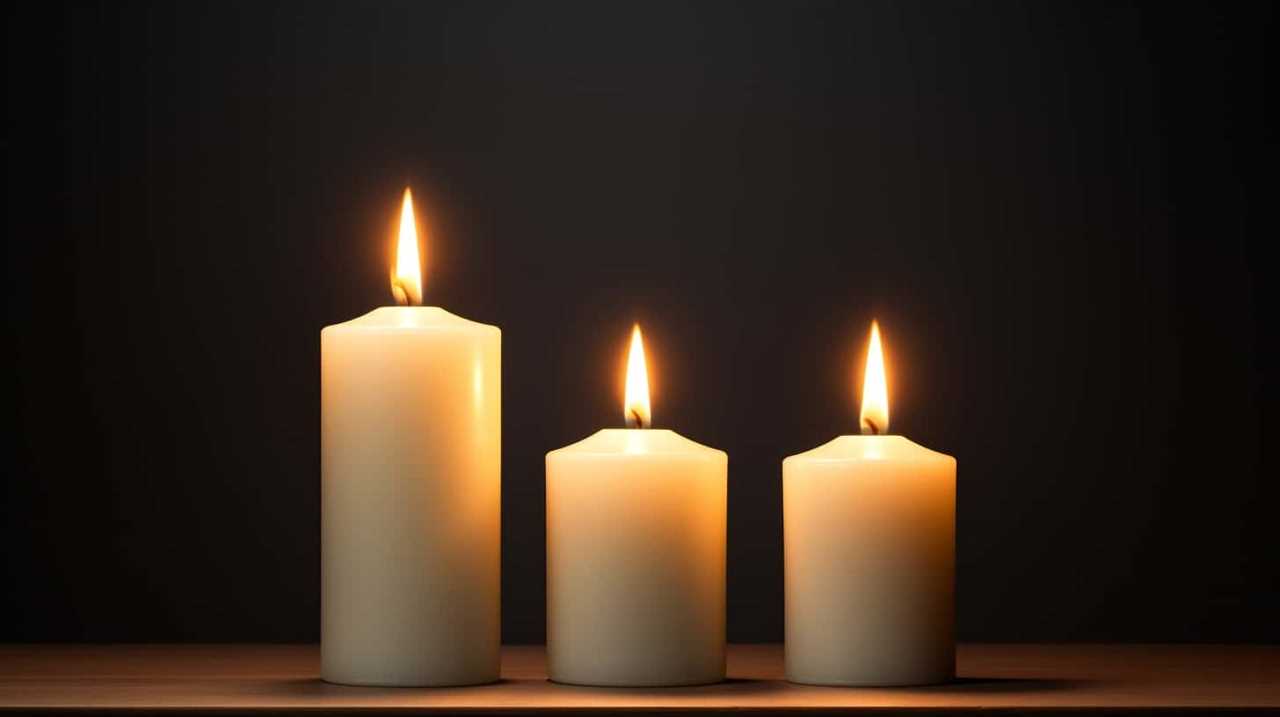
By selecting a candle that resonates with our feelings, we can honor the memory of the deceased and find comfort in our spiritual connection.









